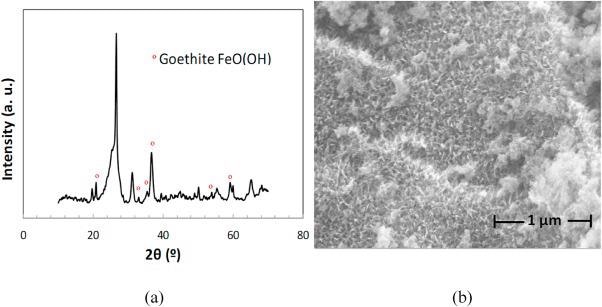New research available in the journal Chemosphere focuses on a novel material made from carbon foam infused with goethite nanoneedles, evaluating its influence on the movement and accessibility of several metals such as Cadmium, Arsenic, and Lead in a commercial soil.

Study: Goethite-based carbon foam nanocomposites for concurrently immobilizing arsenic and metals in polluted soils. Image Credit: H_Ko/Shutterstock.com
What is Goethite?
Goethite is a common soil component and an essential element of many ores and sedimentary deposits. It is also one of the most stable iron oxyhydroxides. In hand specimens, goethite is usually dark or brownish-black. In reflected light, it resembles steel grey with a blue tinge and grey tints that highlights the round curvy structures.
Is Soil Contamination a Serious Threat?
Soil pollution by hazardous metals is a major environmental issue. These metalloids can be toxic to microbes, wildlife, vegetation, and people when found in excessive amounts. Regionalized pollution from a particular dominating agent, such as metal foundry, can significantly impact sediments, seedlings, and the health of the nearby community.
Sources and Causes of Soil Pollution
Over 340,000 polluted soil regions have been discovered throughout Europe. The emission of toxic chemicals utilized or generated in commercial, mining, and agricultural operations, substances originating from fossil fuels, as well as home and municipal waste, are a major source of soil pollution.
Metals that have entered the soil through man-made sources are typically present in more easily accessible states, rendering the soil the vital part of metal(loid)s in the food chain, delivered mostly through vegetation assimilation and animal transmission.
Techniques for Preventing Soil Contamination
Advanced techniques for soil amendment have been developed, which can be conducted in the native ecological system or a laboratory setting and are often categorized according to the type of disinfectant substances used. Each of these solutions is founded on a distinct operational mechanism, with its inherent benefits and limitations. The key issue in industry is to accomplish higher efficacy at a low cost.
What are Nature-Based Solutions (NBS)?
Most recently, several academics have concentrated on deploying seed treatment approaches known as nature-based solutions (NBS) to avoid the conventional practice of excavating and replacing soil. These NBS are intended to treat soil in-situ, guaranteeing the precise conservation of natural habitats without any sort of deterioration of the biological features.
Introduction to Soil Stabilization Process
Soil stabilization is an in-situ treatment technique that involves the addition of synthetic or natural additives to polluted soils to lower the transportation and accessibility of harmful metal(loid)s by absorption, cation exchange, deposition, and reduction reaction.
Biodegradable matter, with or without biochar, has extensively been used as organic additives because they restrict the accessibility of certain pollutants and supply nutrients to the soil that promote plant development and because they are inexpensive.
Limitations of Soil Stabilization Process
It should be noted that after applying these additives, the inherent qualities of the soil may be modified due to an increase in the bioavailability of particular metal(loid)s, such as lead, copper, and zinc, or an increase in the concentration of polycyclic aromatic hydrocarbons (PAHs).
However, this can disrupt the environment and related ecosystems.

XRD pattern (a) and SEM image (b) of the carbon foam impregnated with goethite (CFGo). Janeiro-Tato, I. et. al. (2022)
Research Findings
The researchers have compared the results of carbon foam (CF) with the novel material containing carbon foam impregnated with goethite (CFGo). The key topographical feature of the carbon foams was their heterogeneous porous structure, which included an open network of interconnecting macropores. SEM scans of CFGo revealed that well-dispersed and homogeneous goethite nanoneedles were implanted in the CF external layer.
TPD study of hydroxyl groups on the surface of carbon foams revealed a larger occurrence of carboxylic acid-type groups in CFGo than in CF, based on CO2 desorption at low temperature. In general, the TCLP tests revealed that using CF and CFGo reduced metal solubility in the soil, with this decrease varying depending on the element.
Furthermore, the Tessier studies reported a significant increase in the non-available fraction (RS) for all pollutants examined following CFGo treatment. Finally, the accessible Fe in the amended soil was found to be lower in TCLP testing. The addition of CF and CFGo reduced the pH of the soil from 8.3 to 6.7 and 7.3, respectively
In short, the technique is useful to reduce soil toxicity while conserving the biological components of the soil.
Reference
Janeiro-Tato, I. et. al. (2022) Goethite-based carbon foam nanocomposites for concurrently immobilizing arsenic and metals in polluted soils. Chemosphere. https://www.sciencedirect.com/science/article/pii/S0045653522011389?via%3Dihub
Disclaimer: The views expressed here are those of the author expressed in their private capacity and do not necessarily represent the views of AZoM.com Limited T/A AZoNetwork the owner and operator of this website. This disclaimer forms part of the Terms and conditions of use of this website.